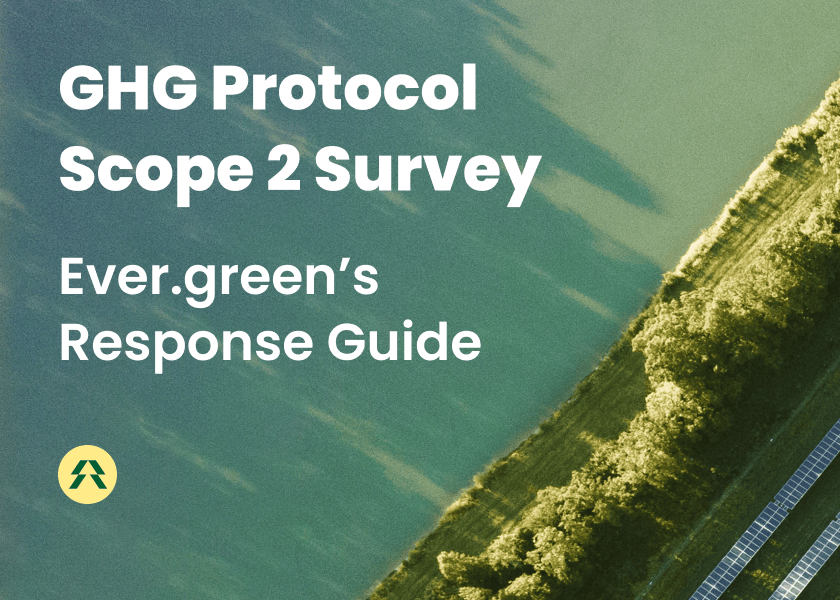Ever.green and Baker Tilly Leaders talk IRA’s Energy Community requirements
Demystifying IRA Energy Community Requirments for project developers who seek to invest in tax credits.
Jun 22, 2023
Given the complexities surrounding the new energy community guidance, we collaborated with Baker Tilly, a leading CPA advisory firm with deep energy industry expertise. Our joint webinar helps to demystify what this guidance means for project developers and organizations who seek to invest in tax credits. Led by Baker Tilly Managing Director Gideon Gradman, Ever.green Chief Product Officer Michael Leggett, and Ever.green Chief Legal Officer Ben Dickson, the webinar translates the guidance into actionable insights. Topics include: how to establish tax credit value for ITCs and PTCs, the energy community definitions and guidance, Ever.green’s mapping tool and marketplace, and more.
The energy transition needs to happen at a community level - moving from fossil fuel to clean energy. The Inflation Reduction Act incentivizes building new clean energy in these areas, known as energy communities, by providing an automatic extra 10% Investment Tax Credit (ITC) or Production Tax Credit (PTC) bonus for projects located there.
What are the benefits of building in energy communities?
The energy community bonus is designed to promote economic growth and increase job opportunities in communities that have been at the forefront of fossil fuel production. The guidance puts a significant emphasis on supporting hard-hit coal communities, as the number of jobs in these areas has been decreasing over time as coal production is phased out. The acceleration of the clean energy transition represents the opportunity to create millions of new jobs there.
Beyond the economic benefits of locating projects in communities impacted by fossil fuels, developing new clean energy in these areas also supports healthier communities. Pollution from fossil fuels is associated with higher rates of cancer, respiratory disease, asthma, birth complications, and more. Research shows that poor communities and communities of color are disproportionately impacted by fossil fuel pollution, because extraction, processing, transport, and combustion facilities are more likely to be cited in and near these communities. The energy transition is an opportunity for both economic and health benefits to flow to communities impacted by fossil fuels.
How much is the energy community bonus worth and how does a project qualify?
The energy community bonus features an additional 2% ITC/PTC, with a potential 5X multiplier on that value. The multiplier depends on meeting the Inflation Reduction Act’s labor requirements, which mandate paying prevailing wages and using qualified apprentices for projects larger than 1MW.
Case in point: If the labor requirements are not met on a project larger than 1 MW, the bonus ITC/PTC remains at 2%. In contrast, if the labor requirements are met, a 5x multiplier is applied and the energy community bonus adds 10% to the ITC/PTC. The Ever.green marketplace includes an interactive map to help you to determine if your project falls in an energy community.
What are the specific requirements for the energy community bonus?
A project will qualify for the energy community bonus if it meets one of the following requirements:
- Located on a brownfield site: A brownfield site, as defined in 42 USC 9601(39), is a “real property, the expansion, redevelopment, or reuse of which may be complicated by the presence or potential presence of a hazardous substance, pollutant, or contaminant,” subject to a fairly detailed list of exclusions, but also including “mine-scarred land”.
- We do not currently display brownfield sites on the Ever.green map, as the locations are all very small and there is still some uncertainty about how those sites are qualified. Please let us know if you believe you are building on a brownfield as your project may qualify.
- Located near a retired coal plant or abandoned coal mine: Located in a census tract or tribal nation where in that tract OR in an adjacent tract, a coal mine has been abandoned since December 31, 2009 OR a coal plant has been decommissioned since December 31, 1999.
- Located in a region with above average unemployment and historical employment by OR tax revenue from the fossil fuel industry. This test, in its entirety, is quite complex. The project must be located in a metropolitan or non-metropolitan statistical area where, (a) at some point since 2010, either (i) 0.17% or more of employment OR (ii) at least 25% of local tax revenues, was related to the extraction, processing, transport, or storage of coal, oil, or natural gas, and (b) the unemployment rate is higher than the annual national average in the previous year.
- In June 2023, the government released the official locations of energy communities that qualify based on the historical fossil fuel employment and the national unemployment rate from 2022. The Ever.green map now uses this source.
- The IRS has not yet released guidance on local tax revenues, so communities that qualify based on this requirement are not displayed on the Ever.green map.
How do I get started selling or buying clean energy tax credits?
If you’re a project developer interested in selling clean energy tax credits to our network of buyers, simply visit the Ever.green marketplace, create a free account, and start uploading your project information. Once you’ve submitted a registration form for your project, we’ll reach out to you and schedule time to talk in more detail.
If you’re a potential tax credit buyer interested in reducing your tax liability, fill out this form to get in touch with our team. We’ll schedule time to walk you through the process from end to end, and explore which of our offerings work best for you.






